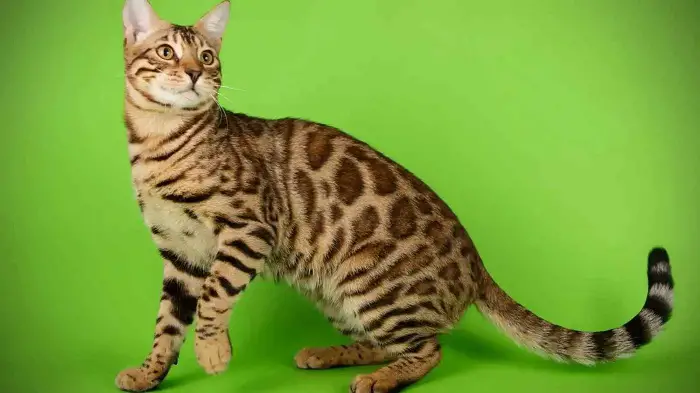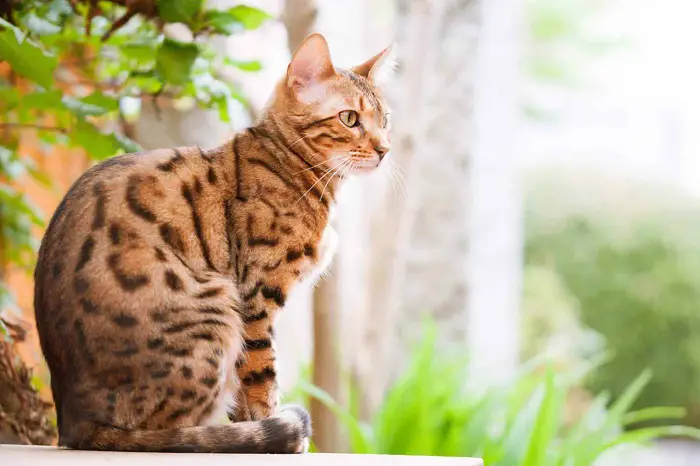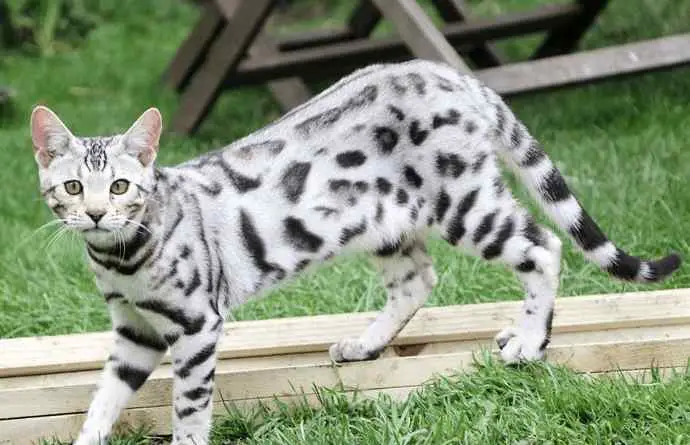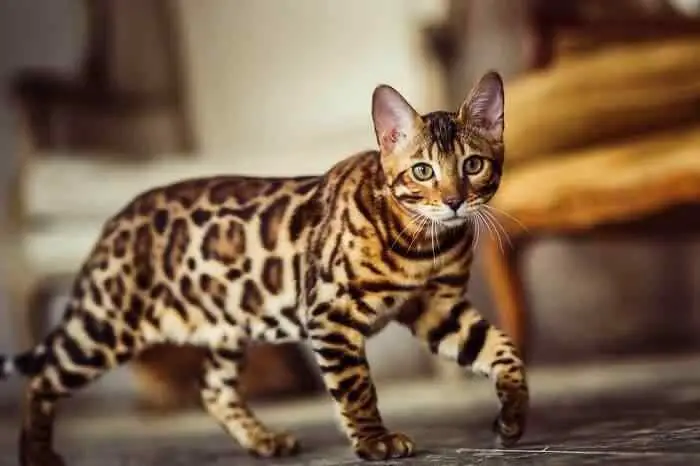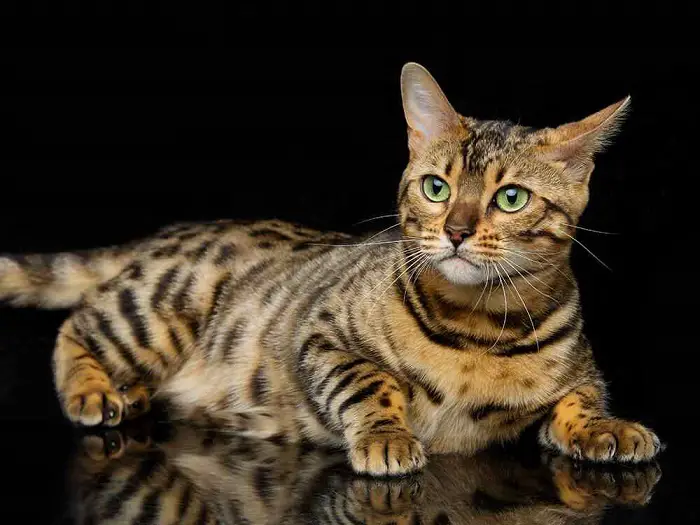The Bengal cat breed is a domestic cat known for its striking and exotic appearance, resembling a small wild leopard. The breed was developed by crossing domestic cats with the Asian Leopard Cat (ALC) in the 1960s and 1970s. The goal was to create a cat with a wild appearance but a friendly and domesticated temperament.
Origin and History of Bengal Cats
The Bengal cat’s origin and history are relatively recent compared to many other cat breeds. The Bengal breed was developed through selective breeding programs to combine a wild leopard’s appearance with a domestic cat’s temperament. The breed’s journey began in the 1960s and 1970s.
The foundation of the Bengal breed can be traced back to the work of Dr. Willard Centerwall, a geneticist at Loyola University in Chicago. In the early 1960s, Dr. Centerwall researched feline leukemia, using domestic cats and the Asian Leopard Cat (ALC) as part of his studies. The ALC is a small, wild feline species native to parts of Asia, and it shares a common ancestor with domestic cats.
Around the same time, in the 1970s, Jean S. Mill, a cat enthusiast in California, began independently working on creating a breed that possessed the beauty and grace of a wild leopard but the personality of a domestic cat. She was inspired by the ALC’s appearance and sought to develop a new breed that combined some of its wild traits with the affectionate nature of domestic cats.
Jean Mill’s early breeding efforts involved crossing ALCs with domestic cats, such as Egyptian Maus, Abyssinians, and American Shorthairs. The first-generation hybrids were called “Foundation Cats” or “F1 Bengals.” These early hybrids were not intended to be pets but to introduce desirable traits from the wild into the domestic cat gene pool.
In the 1980s, other breeders joined in, continuing the work of crossing ALCs with domestic cats. The subsequent generations (F2, F3, etc.) were bred with each other and domestic cats to reduce the percentage of wild blood while retaining the striking appearance and friendly personality.
The breed gained recognition and popularity, and in 1986, The International Cat Association (TICA) granted Bengal cats “preliminary new breed” status. In 1991, they achieved “advanced new breed” status. Over time, the breed was further refined, and in 1998, TICA granted full championship status to Bengal cats, making them eligible to compete in cat shows.
Today, Bengal cats are recognized by various cat registries and associations and have a devoted following of enthusiasts worldwide. The breed continues to captivate people with its exotic appearance and lively, affectionate personality.
Physical Features of Bengal Cat
Bengal cats are renowned for their striking and exotic appearance. Their physical features are a combination of their wild ancestor, the Asian Leopard Cat (ALC), and various domestic cat breeds. Here are the key physical characteristics of Bengal cats:
- Coat: One of the most distinctive features of Bengal cats is their luxurious coat. It is short, dense, and incredibly soft to the touch. The coat comes in various patterns, including:
- Spotted: The most common pattern, resembling the rosettes of a wild leopard.
- Marbled: A unique swirling pattern with a marbled appearance reminiscent of a wild jungle cat.
- Rosetted: A variation of the spotted pattern with more giant, more pronounced rosettes.
- Colors: Bengal cats come in a range of colors, with the most common being brown (often referred to as “brown spotted” or “brown marbled”). Other colors include silver, snow (including lynx point, seal mink, and seal sepia), and charcoal.
- Body: Bengal cats have strong and muscular body, giving them a powerful and athletic appearance. They are medium to large-sized cats, with males generally more prominent than females.
- Head: Their head is relatively small in proportion to their body and has a slightly rounded shape. The profile is slightly convex, with a gentle curve from the forehead to the nose.
- Eyes: Bengal cats typically have large, expressive eyes that are almond-shaped. The eye color can vary and is often influenced by the coat color. Standard eye colors include green, gold, and hazel.
- Ears: Their ears are medium to small, with slightly rounded tips. The ears are set wide apart and have a distinct lynx-like tufting on the tips of some individuals.
- Tail: Bengal cats have a thick, medium-length tail that tapers to a rounded tip. The tail often features rings or bands, giving it an attractive appearance.
- Paws: The paws of Bengal cats are well-proportioned and feature black pads. Some Bengals may have extra-large, wide-set paws, giving them a “wildcat” look.
- Whisker Pads: The whisker pads of Bengal cats are often prominent, adding to their expressive facial appearance.
Height, Weight, and Lifespan of Bengal Cats
The height, weight, and lifespan of Bengal cats can vary depending on the individual cat and its genetics, diet, and overall health. However, there are general ranges that are commonly seen in this breed:
- Height: Bengal cats are medium to large-sized cats. On average, they stand around 9 to 10 inches (23 to 25 cm) tall at the shoulder.
- Weight: The weight of Bengal cats also varies between males and females. Male Bengals typically weigh between 10 to 15 pounds (4.5 to 6.8 kg), while females are generally smaller and lighter, ranging from 8 to 12 pounds (3.6 to 5.4 kg).
- Lifespan: With proper care and a healthy lifestyle, Bengal cats can have a lifespan of around 12 to 16 years or even longer. Some Bengals have been known to live into their late teens or early twenties.
Color Patterns of Bengal Cat
Bengal cats exhibit various captivating color patterns, adding to their unique and exotic appearance. The most common color patterns seen in Bengal cats are:
- Brown Spotted Tabby: This is the most well-known and frequently seen pattern in Bengal cats. The coat features rich brown spots resembling a wild leopard’s rosettes. The spots may vary in size and shape and are often randomly distributed over the body.
- Brown Marbled Tabby: In this pattern, the coat displays a beautiful swirling, marbled appearance reminiscent of a wild jungle cat. The marbling consists of intricate patterns with contrasting colors, creating a visually stunning effect.
Snow Spotted Tabby: Snow Bengals have a lighter-colored coat with spots or rosettes, and their base coat color can vary, resulting in three main variations:
- Seal Lynx Point: The coat is off-white or cream with seal brown (dark brown) spots.
- Seal Mink: The coat is slightly darker than the lynx point, and the spots are also darker.
- Seal Sepia: The coat is the darkest of the three snow varieties, and the spots are dark brown.
- Snow Marbled Tabby: Similar to the brown marbled tabby, the snow-marbled Bengal exhibits a marbled pattern with lighter base colors, creating a captivating contrast.
- Silver Spotted and Marbled Tabby: Silver Bengal cats have a striking appearance with their silver or white base coat color and contrasting black spots or marbling.
- Charcoal Spotted and Marbled Tabby: Charcoal Bengals have a coat with deep black or dark brown spots or marbling on a lighter background color, creating a dramatic and intense appearance.
The Behavior of Bengal Cats
Bengal cats are known for their unique and fascinating behavior, which combines some of the traits of their wild ancestors with the affectionate nature of domestic cats. Here are some critical behavioral characteristics of Bengal cats:
- Playful and Energetic: Bengal cats are highly active and have a lot of energy to burn. They love interactive playtime and enjoy activities that challenge their physical and mental abilities. Providing them with toys, puzzles, and opportunities to climb and explore will help keep them engaged and happy.
- Intelligent and Curious: Bengal cats are intelligent and curious by nature. They are known for their problem-solving abilities and may even learn to open doors or figure out how to reach hard-to-reach places. Their curiosity can sometimes get them into mischief, so providing ample mental stimulation is essential.
- Water Fascination: Unlike many other domestic cat breeds, Bengal cats are often fascinated with water. They may enjoy playing with running water, dipping their paws into the water bowl, or joining their human companions in the shower or bathtub.
- Affectionate and Social: While Bengal cats may have a wild appearance, they are usually affectionate and can form strong bonds with their human family members. They often enjoy being part of family activities and may follow their owners around the house.
- Vocal: Bengal cats are generally quite vocal and can communicate with various sounds, including meows, chirps, and trills. They are not excessively vocal but will let you know when they want attention or something specific.
- Active Hunters: Bengal cats retain some of the hunting instincts of their wild ancestors. They may enjoy interactive play that mimics hunting behavior and may also have a strong prey drive for small moving objects.
- Climbers and Jumpers: Bengals have a natural inclination to climb and jump, another trait inherited from their wild ancestors. Providing them with tall cat trees or shelves will fulfill their desire to climb and give them a vantage point to observe their surroundings.
- Social with Other Pets: Bengals can get along well with other cats and even dogs if adequately introduced. Their social nature and playful attitude open them to forming bonds with other pets in the household.
- Communicative Tail: The tail of a Bengal cat is expressive and can convey its mood. A swishing or twitching tail might indicate excitement or anticipation, while a fluffed-up tail could mean they are feeling threatened or defensive.
Food and Nutrition of Bengal Cats
Proper food and nutrition are essential for the health and well-being of Bengal cats. Like all domestic cats, Bengals require a balanced diet that meets their nutritional needs. Here are some essential considerations for feeding Bengal cats:
- High-Quality Cat Food: Choose high-quality commercial cat food for active and energetic cats. Look for cat food with a balanced mix of proteins, fats, carbohydrates, vitamins, and minerals.
- Protein: like their wild ancestors, Bengals have a higher protein requirement than many other domestic cat breeds. Look for cat food that contains animal-based protein sources, such as chicken, turkey, fish, or lamb. Avoid cat food with excessive plant-based proteins.
- Avoid Fillers: Avoid cat food that contains a lot of fillers, such as corn, wheat, or soy, as these offer little nutritional value and may lead to digestive issues.
- Wet vs. Dry Food: Providing a mix of wet and dry cat food can be beneficial. Wet food helps to keep them hydrated and provides additional moisture, while dry food helps to keep their teeth clean and satisfies their need to chew.
- Portion Control: Pay attention to portion sizes and feeding guidelines provided on the cat food packaging. Obesity can concern Bengals, as they are generally active cats, and overeating can lead to health issues.
- Fresh Water: Ensure that your Bengal cat has access to fresh and clean water at all times.
- Avoid Toxic Foods: Keep your Bengals away from foods toxic to cats, such as chocolate, onions, garlic, grapes, and raisins.
- Treats: Use treats sparingly and choose cat-specific treats made with high-quality ingredients.
- Age and Health Considerations: As your Bengal cat ages, their nutritional needs may change. Consult with your veterinarian to adjust your diet based on age, activity level, and specific health concerns.
- Regular Vet Check-ups: Regular veterinary check-ups are essential to monitor your Bengal cat’s overall health, weight, and nutritional needs.
Care and Management of Bengal Cats
Caring for Bengal cats involves providing a stimulating and enriching environment that meets their physical and behavioral needs. Here are some essential aspects of care and management for Bengal cats:
- Indoor Environment: Bengal cats are best kept as indoor cats to protect them from potential dangers, diseases, and accidents. Create an enriched indoor environment with cat trees, climbing shelves, scratching posts, and interactive toys to stimulate them mentally and physically.
- Litter Box: Provide a clean and accessible litter box for your Bengal cat. Regularly clean the litter box to maintain good hygiene.
- Nutrition: Feed your Bengal cat a balanced, high-quality cat food that meets its nutritional requirements. Be mindful of portion sizes to prevent obesity.
- Fresh Water: Ensure your Bengal cat has access to fresh and clean water at all times.
- Grooming: Bengal cats have short coats that are relatively easy to groom. Regularly brush their coat to reduce shedding and hairballs. Additionally, trim their nails and clean their ears as needed.
- Mental Stimulation: Bengals are intelligent and curious cats that need mental stimulation to prevent boredom. Provide puzzle toys, interactive playtime, and even training sessions to engage their minds.
- Playtime and Exercise: Regular play sessions are essential for Bengals to burn off energy and stay physically fit. Use interactive toys and engage in activities that mimic hunting behavior, as they enjoy being active and playful.
- Social Interaction: Spend quality time with your Bengal cat, as they are social cats that often enjoy the company of their human family members.
- Health Care: Schedule regular veterinary check-ups to monitor your Bengal cat’s health and promptly address potential health issues.
- Environmental Enrichment: Bengals love to explore and climb. Offer them opportunities to climb high places, such as cat trees or shelves, and provide window perches for birdwatching.
- Positive Reinforcement Training: Bengal cats are intelligent and can be trained using positive reinforcement techniques. Training can help them learn commands and tricks and improve the bond between you and your cat.
- Interaction with Other Pets: Gradually introduce Bengal cats to other pets and supervise their interactions until you are confident they get along well.
- Secure Home: Ensure your home is safe and escape-proof, as Bengals may try to explore and access the outdoors.
- Neutering/Spaying: Unless you plan to breed your Bengal cat responsibly, spaying or neutering is recommended to prevent unwanted litters and improve their behavior and health.
The Health of Bengal Cat
Bengal cats are generally healthy and robust cats. However, like all cat breeds, they can be prone to specific health issues. Responsible breeding practices and regular veterinary check-ups are crucial for maintaining their well-being. Here are some health considerations for Bengal cats:
- Hypertrophic Cardiomyopathy (HCM): HCM is a genetic heart condition that can affect Bengal cats and other breeds. Regular cardiac screening by a veterinarian, including echocardiograms, is recommended, especially for breeding cats.
- Patellar Luxation in Cats: This is a condition where the kneecap (patella) dislocates from its normal position, causing lameness and discomfort. It can be seen in some Bengal cats and other breeds. Surgical intervention may be necessary in severe cases.
- Progressive Retinal Atrophy (PRA): PRA is an inherited degenerative eye condition that can turn to vision loss over time. Responsible breeding practices aim to reduce the occurrence of PRA in Bengal cats.
- Flat Chested Kitten Syndrome: Some Bengal kittens may be born with a flattened chest, affecting their ability to breathe correctly. Early veterinary intervention and supportive care are essential for affected kittens.
- Gastrointestinal Issues: Bengals may be more sensitive to certain foods and prone to gastrointestinal issues such as allergies or sensitive stomachs.
- Dental Health: Dental care is essential for all cats, including Bengals. Regular dental check-ups and proper dental hygiene can help prevent dental issues.
- Obesity: Bengals can be prone to obesity, especially if they have a sedentary lifestyle or are overfed. Maintain a balanced diet and encourage regular exercise to prevent weight gain.
- Infectious Diseases: Like all cats, Bengals can be susceptible to common feline infectious diseases, such as feline upper respiratory infections and feline leukemia. Ensure they are up-to-date on vaccinations and keep them away from sick cats.
- Parasites: Regular deworming and flea prevention are essential to keep Bengal cats free from internal and external parasites.
- Kidney Disease: As they age, Bengal cats may become more susceptible to kidney disease. Regular veterinary check-ups can help monitor kidney function and catch any issues early.
The Popularity of Bengal Cats
Bengal cats have been consistently gaining popularity over the years. Their striking appearance, resembling wild leopard or jungle cats, and their affectionate and playful personalities have made them highly sought after as pets. Here are some reasons why Bengal cats have become increasingly popular:
- Exotic Appearance: The Bengal’s unique coat patterns and wild appearance set them apart from other domestic cat breeds, attracting people who appreciate the beauty of a “miniature leopard” in their home.
- Active and Playful Nature: Bengal cats are known for their high energy levels and love for interactive play. They engage with their owners entertainingly and endearingly.
- Intelligence and Trainability: Bengals are brilliant cats and can learn tricks and commands through positive reinforcement training. This adds an element of fun and engagement for their owners.
- Affectionate Personalities: Bengal cats often form strong bonds with their human family members despite their wild appearance. They are social and enjoy being part of the household activities.
- Social Media and Online Exposure: Social media platforms have played a significant role in popularizing Bengal cats. Photos and videos of these striking felines have gone viral, increasing their visibility and popularity.
- Breeder Availability: As Bengal cats gained recognition as a distinct breed, more reputable breeders have focused on breeding and promoting them, making them more accessible to potential owners.
- Unique Coat Colors and Patterns: Bengal cats come in various colors and patterns, providing prospective owners with various choices to suit their preferences.
- Curiosity and Water Fascination: The Bengal’s inquisitive nature, as well as their fascination with water, adds an element of novelty and charm to their behavior.
- Companion for Cat Enthusiasts: Bengal cats are preferred for people with experience with cats and looking for a breed with more challenge and excitement.
Final Talk on Bengal Cats
Bengal cats are a captivating and unique breed that has won the hearts of cat enthusiasts worldwide. Their striking appearance, resembling a wild leopard or jungle cat, combined with their intelligent and affectionate personalities, makes them stand out among other domestic cat breeds.
Initially developed by crossing domestic cats with the Asian Leopard Cat, Bengal cats retain some of the traits of their wild ancestors while being social and affectionate pets. Their active and playful nature makes them excellent companions for families who can provide them with the mental and physical stimulation they need.
Bengal cats’ luxurious coats come in various colors and patterns, from the classic brown spotted tabby to the stunning snow varieties and the striking silver and charcoal variations. Each Bengal cat is a unique and beautiful work of art.
Caring for Bengal cats requires understanding their needs, including a balanced diet, regular exercise, mental stimulation, and plenty of love and attention. Indoor living is recommended to protect them from potential hazards, and responsible breeding practices are essential to maintain their health and prevent hereditary issues.
With proper care, Bengal cats can live long, happy, and healthy lives, forming strong bonds with their human companions and enriching their lives with playful and engaging personalities.
